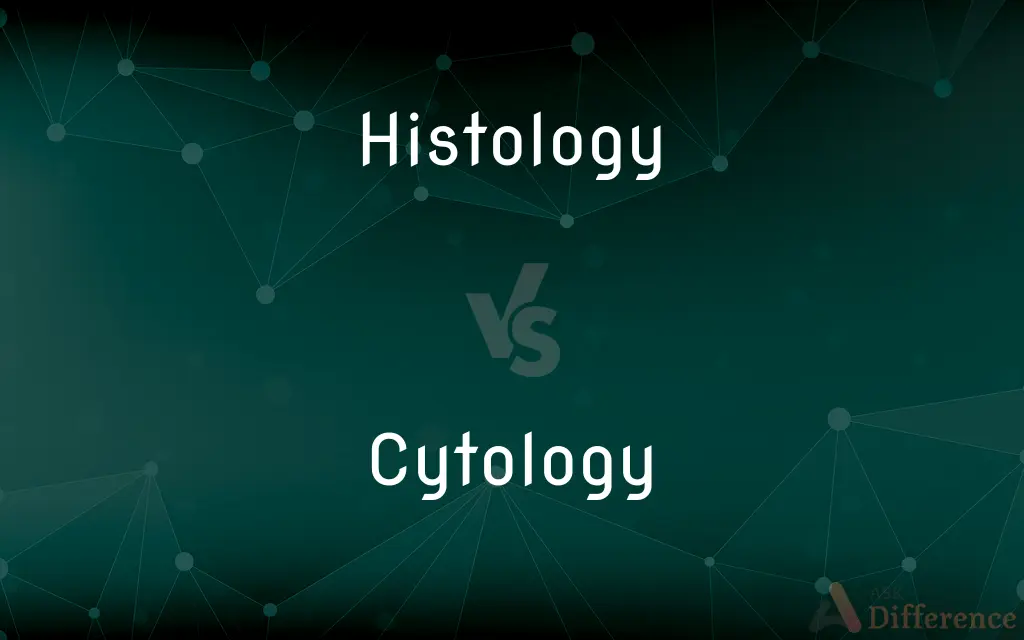Histology vs. Cytology — What's the Difference?
By Tayyaba Rehman — Updated on September 19, 2023
Histology studies the structure of tissues, while cytology examines individual cells. Both are essential in understanding the microscopic organization of organisms.

Difference Between Histology and Cytology
Table of Contents
ADVERTISEMENT
Key Differences
Histology and cytology are both sub-disciplines of anatomy, primarily focusing on the microscopic aspects of organisms. Histology deals with the study of tissues, examining their structure, composition, and functionality. In contrast, cytology zeroes in on individual cells, detailing their characteristics, types, and functions.
In histology, tissues are typically embedded in a substance, thinly sliced, stained, and then observed under a microscope. This allows a deep dive into tissue organization and understanding how different cells come together to form organs. Cytology, on the other hand, often involves the examination of cell smears or suspensions under a microscope to analyze the morphology and structure of individual cells.
One of the primary objectives of histology is to provide context—how different types of cells interact and relate to form functional units within an organ. Cytology, while it can provide some information about how cells interact, is more focused on studying the minute details and inner workings of single cells.
Histology often finds application in understanding broader physiological processes and diseases, given its organ and system-wide context. Cytology is frequently used in clinical settings, especially for the early detection of cancers through procedures like the Pap smear.
In essence, while histology provides a panoramic view of tissue organization, cytology offers a magnified perspective on individual cells, each vital in its way for comprehensive biological understanding.
ADVERTISEMENT
Comparison Chart
Main Focus
Tissue
Individual Cells
Preparation Technique
Embedding & slicing
Smears or suspensions
Provides Context
Tissue organization & organ formation
Cellular morphology & function
Common Applications
Physiological processes & diseases
Detection of cancers, cell health
Scale of Study
Multi-cell structures
Single-cell structures
Compare with Definitions
Histology
Analysis of the microanatomy of cells and tissues, usually through staining and microscopy.
Histology slides provide a colorful window into the microscopic world of tissues.
Cytology
The branch of biology that studies the structure and function of cells.
Cytology tests can help detect cellular abnormalities early on.
Histology
A branch of anatomy that deals with the organization of cells into tissues and organs.
Through histology, researchers can gain insights into tissue regeneration.
Cytology
Examination of cells under a microscope to determine their morphology.
Cytology studies revealed crucial insights into cell division processes.
Histology
The scientific study of tissues and their microscopic structures.
Histology labs require precise slicing techniques to examine tissues effectively.
Cytology
The detailed study of cell composition, physiology, lifecycle, and interactions.
Cytology is fundamental in understanding the building blocks of life.
Histology
A discipline that deciphers how multiple cells collaborate to form tissues.
Advances in histology have deepened our understanding of organ development.
Cytology
Analysis of single cells to diagnose diseases, especially cancers.
Regular cytology screenings can be lifesaving, especially for high-risk groups.
Histology
The microscopic examination of the structural composition of biological tissues.
Histology plays a pivotal role in identifying tissue abnormalities.
Cytology
The discipline that unravels the microscopic details of individual cells.
Modern cytology techniques enable visualization of cellular organelles in great detail.
Histology
Histology, also known as microscopic anatomy or microanatomy, is the branch of biology which studies the microscopic anatomy of biological tissues. Histology is the microscopic counterpart to gross anatomy, which looks at larger structures visible without a microscope.
Cytology
The branches of biology and medicine concerned with the structure and function of plant and animal cells.
Histology
The study of the microscopic structure of tissues.
Cytology
The branch of biology that deals with the formation, structure, and function of cells.
Histology
The anatomical study of the microscopic structure of animal and plant tissues.
Cytology
(biology) The study of cells.
Histology
The microscopic structure of tissue.
Cytology
Cytopathology.
Histology
(biology) The study of the microscopic structure, chemical composition and function of the tissue or tissue systems of plants and animals.
Cytology
The branch of biology that studies the structure and function of cells
Histology
That branch of biological science, which treats of the minute (microscopic) structure of animal and vegetable tissues; - called also histiology.
Histology
The branch of biology that studies the microscopic structure of animal or plant tissues
Common Curiosities
What's the primary difference between histology and cytology?
Histology studies tissues, while cytology examines individual cells.
Which is more comprehensive for studying organs?
Histology provides a broader view of tissue organization, crucial for understanding organs.
Which technique involves embedding and slicing?
Histology typically involves embedding and slicing tissues for examination.
Can cytology detect infections?
Yes, cytology can identify abnormal cells, including those caused by infections.
How do researchers study cell aging?
Both histology and cytology methods can be used to study cell aging by examining tissues and individual cells, respectively.
What is the Pap smear related to?
The Pap smear is a cytology test used to detect cervical cancer.
Are special stains used in histology?
Yes, histology often uses stains to highlight different tissue components.
What tools are essential for cytology?
Microscopes are indispensable for cytology to visualize and study cells.
Which field has contributed more to regenerative medicine?
Both have roles, but histology offers insights into tissue organization, vital for tissue engineering in regenerative medicine.
Are both histology and cytology used for cancer diagnosis?
Yes, histology examines tissue samples, while cytology checks for abnormal cells, often in early cancer detection.
Is cytology always performed on fresh samples?
Not always; cytology can be done on fresh, frozen, or preserved cell samples.
Is cytology limited to only animal cells?
No, cytology encompasses the study of all cells, including plant, bacterial, and fungal cells.
Can histology help in drug testing?
Absolutely, histology can determine how drugs affect tissue health and structure.
How do histologists differentiate between tissue types?
Histology utilizes various staining techniques to distinguish between different tissue components.
Are there any overlaps between histology and cytology?
Yes, both histology and cytology can provide insights into cellular structures, but their primary focuses differ.
Share Your Discovery

Previous Comparison
Wrung vs. Rung
Next Comparison
Study vs. ResearchAuthor Spotlight
Written by
Tayyaba RehmanTayyaba Rehman is a distinguished writer, currently serving as a primary contributor to askdifference.com. As a researcher in semantics and etymology, Tayyaba's passion for the complexity of languages and their distinctions has found a perfect home on the platform. Tayyaba delves into the intricacies of language, distinguishing between commonly confused words and phrases, thereby providing clarity for readers worldwide.
















































